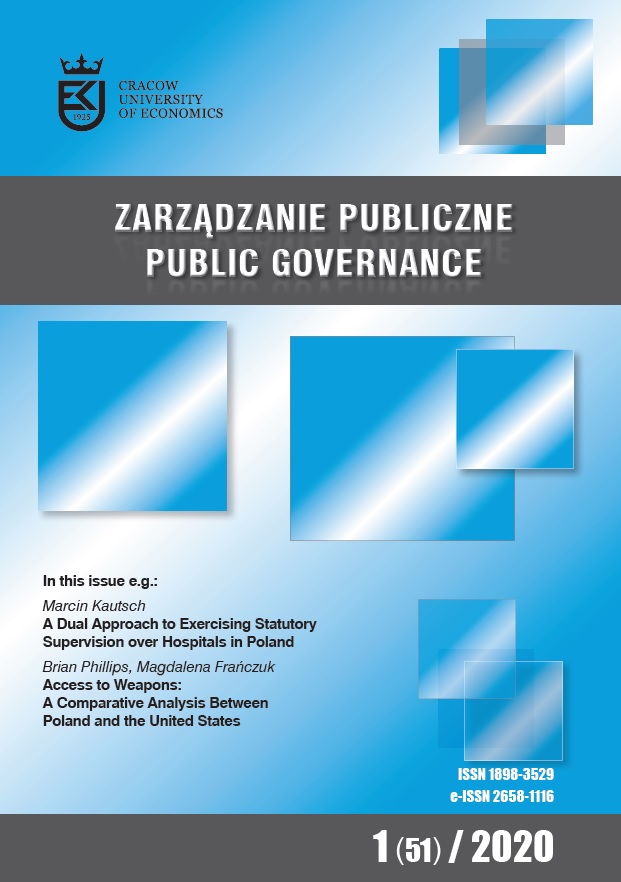Understanding Public Value Through Its Methods
DOI:
https://doi.org/10.15678/ZP.2020.51.1.04Keywords:
public value, management methods, instruments, multiple factor analysis, public value creationAbstract
Objectives: The article has two main purposes. On the one hand, it shows how public value is defined and through what management tools it is created. On the other hand, it presents how representatives of various scientific disciplines describe the desired features of instruments creating public value and, based on this, how they evaluate the existing tools.
Research Design & Methods: We apply multiple factor analysis (MFA) on data collected from scholars from different scientific disciplines. The dimensions of various groups of methods described by the respondents made it possible to reveal the similarities and differences in their perceptions.
Findings: The study demonstrates that a scientific disciplinal background can influence perceptions of the benefits of management methods to deliver public value. Knowledge of background can make public managers aware of prejudices towards particular tools as well as it helps identify the most adequate one for each dimension of public value.
Contribution / Value Added: Our paper contributes to the body of knowledge of public value by showing how different perspectives can be integrated and helpful for describing diversified sets of tools. We outline how the respondents perceive the delivery of public value through management methods and, from this perspective, how they evaluate various tools.
Article classification: research article
JEL classification: H11, H83, C38
Downloads
References
Abdi, H., Williams, L. J., & Valentin, D. (2013). Multiple factor analysis: Principal component analysis for multitable and multiblock data sets: Multiple factor analysis. Wiley Interdisciplinary Reviews: Computational Statistics, 5(2), 149–179. https://doi.org/10.1002/wics.1246.
Alford, J., Douglas, S., Geuijen, K., & ‘t Hart, P. (2017). Ventures in public value management: Introduction to the symposium. Public Management Review, 19(5), 589–604. https://doi.org/10.1080/14719037.2016.1192160.
Alford, J., & Hughes, O. (2008). Public Value Pragmatism as the Next Phase of Public Management. The American Review of Public Administration, 38(2), 130–148. https://doi.org/10.1177/0275074008314203.
Benington, J. (2015). Public Value as a Contested Democratic Practice. In J. M. Bryson, B. C. Crosby, & L. Bloomberg (Eds.), Creating Public Value in Practice: Advancing the Common Good in a Multi-Sector, Shared-Power, No-One-Wholly-in-Charge World (pp. 29–48). CRC Press.
Blaug, R., Horner, L., Lekhi, R., & Kenyon, A. (2006). Public value and local communities. The Work Foundation.
Bozeman, B. (2007). Public Values and Public Interest Counterbalancing Economic Individualism. Georgetown University Press. Retrieved from http://public.eblib.com/choice/publicfullrecord.aspx?p=547786.
Bryson, J. M., Crosby, B. C., & Bloomberg, L. (2015). Introduction. In J. M. Bryson, B. C. Crosby, & L. Bloomberg (Eds.), Creating Public Value in Practice: Advancing the Common Good in a Multi-Sector, Shared-Power,No-One-Wholly-in-Charge World (pp. 1–28). Boca Raton: CRC Press.
Bryson, J. M., Sancino, A., Benington, J., & Sørensen, E. (2016). Towards a multi-actor theory of public value co-creation. Public Management Review, 1–15. https://doi.org/10.1080/14719037.2016.1192164.
Coats, D., & Passmore, E. (2007). Public Value: The Next Steps in Public Service Reform. The Work Foundation.
Ćwiklicki, M. (2016), Comparison of public value measurement frameworks. Zarządzanie Publiczne, 1(35), 20–31. https://doi.org/10.15678/ZP.2016.35.1.02.
Ćwiklicki, M. (2019), Metody zarządzania wartością publiczną. Scholar.
Diefenbach, F. E. (2011). Entrepreneurship in the public sector: When middle managers create public value (1st ed). Gabler.
Farr, M. (2016). Co-Production and Value Co-Creation in Outcome-Based Contracting in Public Services. Public Management Review, 18(5), 654–672. https://doi.org/10.1080/14719037.2015.1111661.
Kalambokidis, L. (2014). Creating Public Value with Tax and Spending Policies: The View from Public Economics. Public Administration Review, 74(4), 519–526. https://doi.org/10.1111/puar.12162.
Kelly, G., Muers, S., & Mulgan, G. (2002). Creating Public Value: An Analytical Framework for Public Service Reform. The Cabinet Office Strategy Unit, United Kingdom.
Mendel, S. C., & Brudney, J. L. (2014). Doing Good, Public Good, and Public Value: Why the Differences Matter. Nonprofit Management and Leadership, 25(1), 23–40. https://doi.org/10.1002/nml.21109.
Meynhardt, T. (2009). Public Value Inside: What is Public Value Creation? International Journal of Public Administration, 32(3–4), 192–219. https://doi.org/10.1080/01900690902732632.
Moore, M. H. (1995). Creating public value: Strategic management in government. CHarvard University Press.
Nabatchi, T. (2018). Public Values Frames in Administration and Governance. Perspectives on Public Management and Governance, 1(1), 59–72. https://doi.org/10.1093/ppmgov/gvx009.
Osborne, S. P., Radnor, Z., & Nasi, G. (2013). A New Theory for Public Service Management? Toward a (Public) Service-Dominant Approach. The American Review of Public Administration, 43(2), 135–158. https://doi.org/10.1177/0275074012466935.
Osborne, S. P., Radnor, Z., & Strokosch, K. (2016). Co-Production and the Co-Creation of Value in Public Services: A suitable case for treatment? Public Management Review, 18(5), 639–653. https://doi.org/10.1080/14719037.2015.1111927.
Papi, L., Bigoni, M., Bracci, E., & Deidda Gagliardo, E. (2018). Measuring public value: A conceptual and applied contribution to the debate. Public Money & Management, 1–8. https://doi.org/10.1080/09540962.2018.1439154.
Rhodes, R. A. W., & Wanna, J. (2007). The Limits to Public Value, or Rescuing Responsible Government from the Platonic Guardians. Australian Journal of Public Administration, 66(4), 406–421. https://doi.org/10.1111/j.1467-8500.2007.00553.x.
Rutgers, M. R. (2015). As Good as It Gets? On the Meaning of Public Value in the Study of Policy and Management. The American Review of Public Administration, 45(1), 29–45. https://doi.org/10.1177/0275074014525833.
Smith, R. (2004). Focusing on public value: Something new and something old. Australian Journal of Public Administration, 63(4), 68–79. https://doi.org/10.1111/j.1467-8500.2004.00403.x.
Spano, A. (2009). Public Value Creation and Management Control Systems. International Journal of Public Administration, 32(3–4), 328–348. https://doi.org/10.1080/01900690902732848.
Try, D., & Radnor, Z. (2007). Developing an understanding of results‐based management through public value theory. International Journal of Public Sector Management, 7(20), 655–673.
Van der Wal, Z., Nabatchi, T., & de Graaf, G. (2015). From Galaxies to Universe: A Cross-Disciplinary Review and Analysis of Public Values Publications From 1969 to 2012. The American Review of Public Administration, 45(1), 13–28. https://doi.org/10.1177/0275074013488822.



